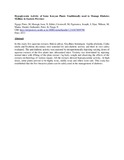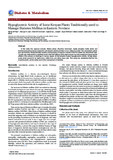| dc.contributor.author | Ngugi, Piero, M | |
| dc.contributor.author | Murugi, Joan, N | |
| dc.contributor.author | Kibiti, Cromwell, M | |
| dc.contributor.author | Ngeranwa, Joseph, J | |
| dc.contributor.author | Njue, Wilson, M | |
| dc.contributor.author | Maina, Daniel | |
| dc.contributor.author | Gathumbi, Peter, K | |
| dc.contributor.author | Njagi, N | |
| dc.date.accessioned | 2013-02-13T13:14:49Z | |
| dc.date.available | 2013-02-13T13:14:49Z | |
| dc.date.issued | 2011 | |
| dc.identifier.citation | Diabetes & Metabolism, 2011, 2:8 | en |
| dc.identifier.issn | 2155-6156 | |
| dc.identifier.uri | http://erepository.uonbi.ac.ke:8080/xmlui/handle/123456789/9790 | |
| dc.description.abstract | In this study five aqueous extracts; Bidens pilosa, Strychnos henningsii, Aspilia pluriseta, Catha edulis and Erythrina abyssinica were screened for anti-diabetic activity and their in vivo safety evaluated. The anti-diabetic activity was assessed by intraperitoneally injecting varying doses of aqueous extracts of the five plants into alloxanised mice.
Toxicity was determined by injecting normal mice with 450mg of the plant extract / kg body weight and observing the effects of the extracts on histology of various organs. All the extracts showed hypoglycaemic activity. At high doses, some plants proved to be highly toxic, mildly toxic and others were safe. This study has established that the five
bioactive plants can be safely used in the management of diabetes. | en |
| dc.language.iso | en | en |
| dc.subject | Anti-diabetic activity | en |
| dc.subject | In vivo toxicity | en |
| dc.subject | Histology | en |
| dc.subject | Alloxanised mice | en |
| dc.title | Hypoglycemic Activity of Some Kenyan Plants Traditionally used to Manage Diabetes Mellitus in Eastern Province | en |
| dc.type | Article | en |


